Hello,
Welcome to today’s edition of Kitchen Projects. Thank you so much for being here.
Today it’s a classic… Bread and butter pudding ft. my favourite serving suggestion: Fried in butter. It really is one of the best desserts of all time.
Over on KP+, it’s another dessert to feed a crowd: Conceptual tiramisu. Open your mind and build this beautiful caramel poached mandarian treat and learn about the intersection of trifle and tiramisu! Click here to read it.
Kitchen Projects is 100% reader funded; By joining KP+, you will support the writing and research that goes into the newsletter and get access to baking Q&As with me, extra content, community chat threads, and more. Subscribing is easy and only costs £5 per month:
Love,
Nicola
The dessert hug
Around this time of year, it's all about comfort. And bakes that can feed a crowd. Last month I posted a chat thread for KP+ asking about comfort bakes. A few recipes came up a lot - sticky toffee pudding, banana bread, fruit crumble, and, of course, bread and butter pudding.
Bread and butter pudding is an absolute classic. And this week, I was not messing with convention too much with a rich pudding with a citrus and spiced infused custard running throughout, with a backbone of brown butter. I'll show you how to nail the B&B format every time - think of this as an 'in your back pocket' type recipe, a formula you can turn to time and time again whilst scaling up and down the size or flavours depending on your mood.
If you have a crowd to feed, over on KP+, I'm talking about conceptual Tiramisu and have a recipe for a tiramisu/trifle hybrid ft. caramel poached mandarins. RUN, don't walk. And by ‘run’, I mean click on the link below for the recipe:
The intersection of french toast and bread and butter pudding
After pondering on this recipe, I have one question to ask myself… Is bread and butter pudding… french toast? The answer is not 'no', but also not 'yes'. The main difference is the structure: French toast (or eggy bread, as it is known in the UK) must be an intact slice, whilst bread and butter pudding is a single, sliceable mass. So, though the two aren't twins, they are definitely siblings.
French toast has a long and illustrious history that takes us back to ancient Rome. The first known recipe for french toast appears in Apicius, the Roman cookery book compiled in 500AD. It reads, "Break fine white bread, crust removed, into rather large pieces which soak in milk [and beaten eggs], fry in oil, cover with honey and serve." In the following centuries, it appeared in cookbooks worldwide, officially showing up in the UK in 1728, in 'The Compleat Housewife' by Eliza Smith. In true 18th-century British fashion, the recipe features a lot of heavy spicing and dried fruit. Before this publication, the B&B pudding-style desserts were known as 'white pot' in the UK and may have featured rice and bone marrow. I'm thankful that modern recipes have swung toward more french style custard recipes, though the dried fruit still remains in a lot of modern recipes.
For today, I won't be too prescriptive with the formula. We'll discover which bread is best - and how to cut it - as well as the ideal custard formula and soaking times. Let’s go deeper
First: Understanding egg coagulation
At the heart of this dessert is custard. One area of constant fascination and discovery to me is custards and their ratios. In its simplest form, custard is a mixture of dairy and eggs. It may contain sugar, like a custard tart, but we also have savoury custards for dishes like quiches. Coagulation temperature is one of the most important things to understand when developing a custard recipe. It's essential to understand the final dish's texture and give us cues on how to cook or bake something.
Coagulation is when the proteins in eggs thicken and knit together to create a cohesive, solid mass. Consider frying an egg - when the egg goes into the frying pan, it is a relatively runny mass that can be freely agitated. As it heats up, the molecules in the egg begin to move around quickly, and the proteins in the egg white and yolk unfurl, bump into each other and bond together. As a result, the once free-flowing egg becomes a solid. This is an irreversible process. Whether you cook eggs in a cake, custard, or scramble, it's this same coagulation process. The thing that changes or impacts the behaviour is what the eggs are mixed with.
On their own, egg proteins coagulate between 60c-70c. Once you start adding things like sugar, milk or cream, this temperature rises. This is because there are things physically blocking the egg proteins from meeting, which delays the proteins from knitting (or clumping!) together. This rise in coagulation temperature is not infinite - if you apply enough heat, the egg proteins *will* find one another, they *will* bond together, and the mixture will curdle. Paying close attention to the temperature is essential in preventing this from happening.
The ideal setting temp for your custard will be contingent on the relative proportion of eggs to dairy. This relative proportion will also define the character of the custard. No matter how hard you cook a creme anglaise, it will never become fully solid due to the lack of coagulable proteins.
Let's consider creme Anglaise as a starting point. I know, from experience, that creme Anglaise, which has a 10% concentration of yolks, will begin setting at around 80c, with the ideal at 82c-84c for a thick, spoon-coating quality. I also know that eggs alone will coagulate between 60-70c. Knowing these two things, we can work backwards to guesstimate the setting temperature.
Today's final custard is 15% yolks. We are not looking for a fully set custard, nor will that be achievable, so we will aim to cook our puddings to around 74c - 78c for a perfectly dense goo.
The tests
Here's the overview of the testing matrix - we'll go into detail on each column after:
First: The base / what bread to use
A few months ago, I was testing a base brioche recipe, and after defrosting my freezer this week (glamorous), I came across a loaf and kickstarted my B&B pudding tests.
So the story goes, bread and butter pudding should utilise 'leftover' or stale bread. Perhaps this was true in the past, but nowadays, it's a bit of a myth. How often do we have leftover bread, let alone brioche, these days? The reality is: in my world, if I'm making bread and butter pudding, I'll probably have made the bread that goes in it. Although, in theory, you can use any bread for B&B pudding, there are some clear frontrunners. For today's newsletter, I tested brioche vs cheap white supermarket bread vs croissants,
Brioche was the clear winner here, though any enriched dough would work. Enriched doughs tend to be quite structured breads because they contain fat and eggs. When it cools, the crumb is bolstered by the hardening fat and the firm egg proteins. As well as this, brioche is exceptionally well-suited for recipes requiring soaking because of the butter that inherently coats the crumb. Cinnamon buns, or panettone, for example, would work well.
Unlike lean bread, which will fall apart, the fat-waxed brioche crumb will prevent over-absorption. This is because water and fat do not mix - butter acts as a barrier. The white supermarket bread was so one-note and textureless that it wasn't very enjoyable to eat. If it had been stale, it might have been better. And I expect a heartier bread like sourdough to work, though I'm not sure I'd love the flavour combination.
Croissants have also entered the B & B pudding arena in recent years, and I'm not a fan - the holey crumb does not lend itself well to a cohesive pudding. Although it sounds good on paper, it doesn't work in reality.
Type of custard
In the past, I've always used my classic creme Anglaise recipe to build B&B puddings. But was this really the best? Perhaps a higher percentage of yolks or, conversely, whole eggs would be better? To find this perfect B&B pudding custard, I tested out a few different options. I mainly focused on the proportion of eggs (10% vs 15% vs 20%) and the proportion of milk and cream.
Overall, my favourite was the creme brulee mixture that used all egg yolks and had 15% egg in proportion to the other ingredients - it was just delightfully rich and made a dense pudding with an unbeatable flavour. The creme Anglaise mixture, which has a relatively low egg %, lacked substance, whilst the whole egg custard was lighter, likely owing to the overall higher hydration. If separating eggs for custard drives you mad, by all means, you can use whole eggs, but expect the custard to be a bit less rich and to cook slightly faster thanks to the coagulation temp of whole eggs.
The ratio of custard to bread and soaking time
One of the most important things for B&B pudding is perfecting the ratio between custard and bread. We want the bread to absorb the custard but not dissolve completely, and we want it to be juicy but not too wet. I tried several ratios and left two puddings overnight before baking to see if a long absorption made a difference.
Surprisingly (or perhaps not), the bread that was soaked overnight was much drier. Definitely not worth doing, in my opinion.
How to cut the bread
Another variable for B&B pudding is how to build it, including whether or not to remove the crusts. You may be thinking - does the way I cut the bread actually matter? The answer is a resounding YES! I tried slicing the bread and building it in layers, ripping it up into craggy pieces and cutting it into even, rectangular blocks.
I have to say, crustless B&B pudding was joyless, a smoosh of misery, way too sloppy and homogenous. Although it's totally down to preference, I wonder why you would forgo the crust of the bread; As bread bakes, the crust undergoes deep Maillard reactions and is a main source of flavour. I found that the ripped bread also had somewhat disappointing results - very homogeneous and wet; Presumably, the thin whisps of bread (a result of ripping) were completely obliterated by the custard.
Water bath cooking
Using a water bath for B&B pudding was something I was shown by a chef during a consultancy project a few years ago - it surprised me! I had never considered this before, but it makes sense since the best B&B pudding will have a smooth custard. I often roll my eyes when I see a recipe that calls for a water bath… I mean, for this recipe, does it really make a difference? I tried it out.
What is and WHY use a water bath? We can use a water bath to promote gentle cooking in the oven by partially submerging what we are cooking in water (watertight tins / general apparatus must be used, of course!) But why? Well, heat exchange, which happens when you put something in the oven, is quite different when it comes to water vs air. The water absorbs some of the heat from the oven. This regulates the temperature and results in a more gentle and even bake. As water has a max temperature of 100c, so long as the oven temperature isn't so high, it is turning it all to steam immediately (please don't do this, this would be a mess!), meaning a symbiotic relationship forms between the water and whatever is submerged in it. In this case, as the B&B pudding heats up, some heat is transferred to the water, and vice versa, minimising temperature fluctuations and allowing for a smooth custard.
The B&B puddings cooked without a water bath were much firmer, even though I'd kept a close eye on the temp during cooking. The B&B puddings cooked within a water bath were silkier and smoother and had a much more lush custard. Because the custard is soaked into the bread, any curdling is much less noticeable, but that doesn't mean we shouldn't take measures to avoid it!
The deal with butter
I mean, the pudding is called bread & butter pudding, so surely butter MUST feature… right?! I was surprised that some recipes online skipped this step entirely. I tried a few ways - from spreading soft butter on the bread, brushing with melted butter and omitting altogether.
Similar to the reasonings for brioche being ideal for B&B pudding, butter helps control the absorption of custard because of SCIENCE! You know how fat and water don't mix? The butter on the bread functions as a quasi barrier, a bodyguard if you will - the custard is limited on how much it can penetrate the bread. The B&B puddings made with buttered bread had a firmer texture that held together better. However, I found the butter's flavour quite overwhelming - even when spread thinly, it was too dominant. For the final recipe, I've compromised with a thin brushing of melted butter (or brown butter for even more flavour) on one side of each slice.
Finishing
One of the best dessert experiences I've ever had was in San Sebastian when I ate two portions of Torrijas - fried milk bread - in a row. So, as soon as I see an opening for frying my bread-based desserts, I jump at it. I do like bread and butter pudding warm and fresh from the oven, but there is one ultimate way to finish that you'll really love.
By baking our B&B pudding in a loaf tin ahead of time and then allowing it to chill, we can slice and reheat it. This can be done in the oven until crispy or by giving french toast treatment in the frying pan with butter. You could also deep fry it like they do at Cafe Cecilia (I haven't actually been to this restaurant, but I know people are obsessed with their deep-fried bread pudding). Serving with additional custard or double cream is also recommended. You can also serve it with mandarins gently cooked in a boozy caramel syrup.
Get the recipe for the mandarins on KP+:
Adaptions
I love this recipe because it is very scaleable. I had great results cooking miniature B&B puddings in ramekins and large versions. I have shown how to make a deep loaf pan, but it would be just as successful in a low wide pan. By all means, serve by the spoonful - just reduce the cooking time for these dishes and keep an eye on the temp.
Adapting this recipe is very easy - for today's recipe, I have infused the milk with citrus peels and cinnamon, but this could have easily been cardamom and vanilla, coffee beans, or other spices. You could also throw in a handful of chocolate chips, dried fruit as you're building it, or a spoon of your favourite jam or conserve. As long as you pay attention to the internal temperature of the pudding, you're good to go!
Bread and butter pudding
I used an 8.5inch x 4.5inch loaf tin
Serves 6-8
Pudding base
375-400g brioche or any enriched bread in 2cm slices
70g melted or browned butter (link to the method)
Spiced Custard
130g whole milk
300ml double cream
1 cinnamon stick
1 x orange, peel only
½ lemon, peel only
Optional: vanilla pod
70g caster sugar
90g egg yolks (or whole eggs, for less rich!)
Plus: demerara sugar to sprinkle on top
To serve: Poached caramel mandarins (recipe on KP+) and more cream/ice cream/custard, if desired.
Method
First, make the custard infusion: Heat milk and cream with citrus peels and spices. Bring to a boil, switch off and cover, leaving to infuse for at least 30 minutes but up to several hours.
To prepare the custard, add the sugar to the milk/cream mixture and heat until steaming. Meanwhile, place the egg yolks in a heatproof bowl. Whilst whisking the eggs, pour the hot milk/cream mixture and whisk well. Pass through a sieve to remove the peels and cinnamon stick. Set aside.
To prepare the pudding, brush one side of each brioche slice with the melted browned butter. Leave to cool slightly, then cut into 2-3cm squares. Set aside.
Pile the brioche squares loosely into your lined loaf tin. It's nice if there are pockets for the custard to settle into.
Now pour the custard over - go slowly, filling in all the gaps and ensuring each piece of bread gets a soaking. If the ones on the top miss out, that's okay - it'll just be extra crispiness.
Sprinkle with demerara sugar. If using a water bath: Place the loaf tin in a larger baking tray with high sides and fill halfway with boiling water. You can skip this step, but you will get the best results with a water bath, but please make sure your tin is watertight first!
Bake at 160c for 40-50 minutes or until a thermometer reads at least 74-75c. Start checking after 40 minutes.
Either serve immediately or leave to cool completely, then cut into thick slices and fry in butter, around 1-2 minutes per side.
Serve with cream or custard, plus caramel poached mandarins in their syrup.







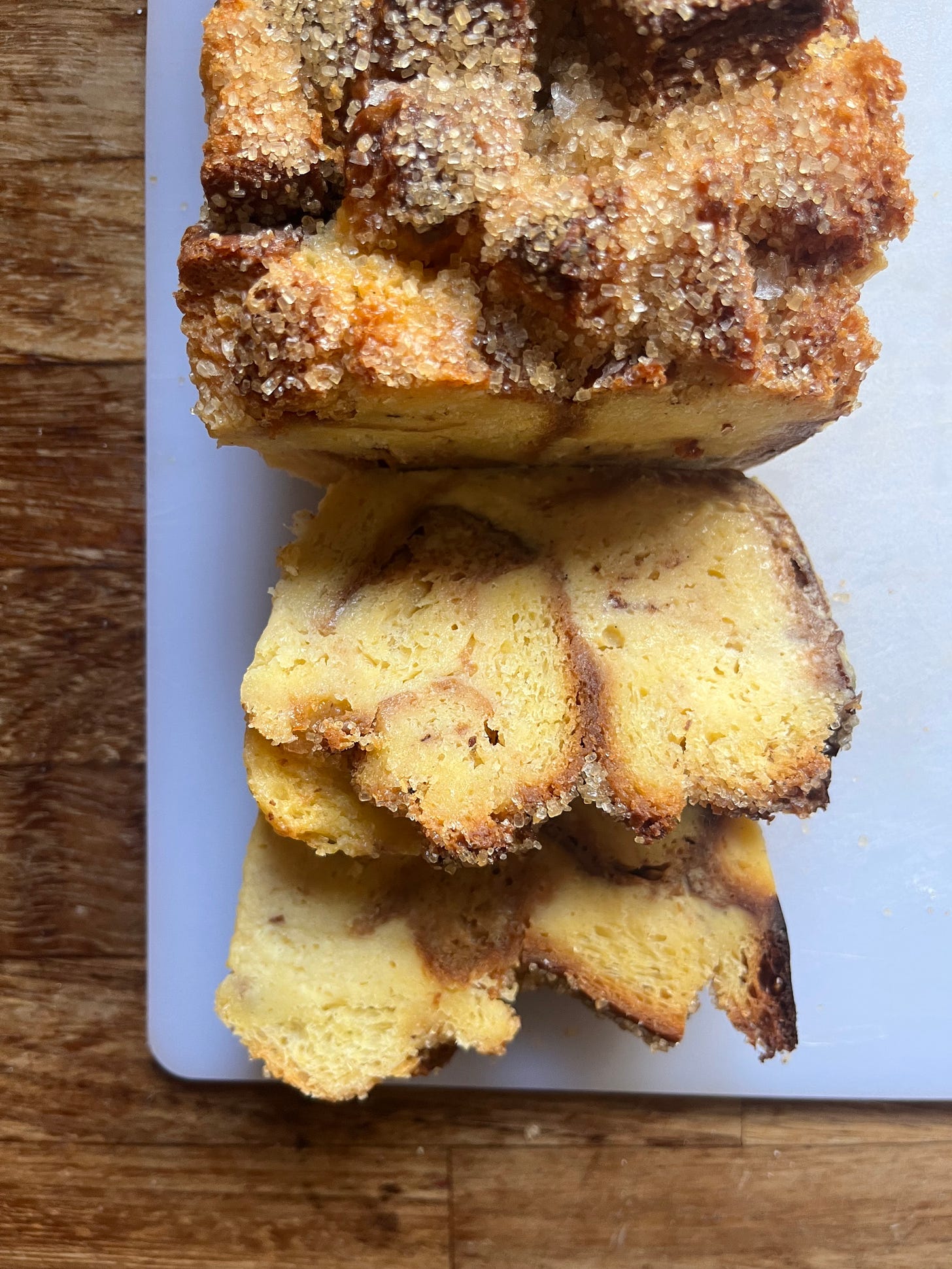

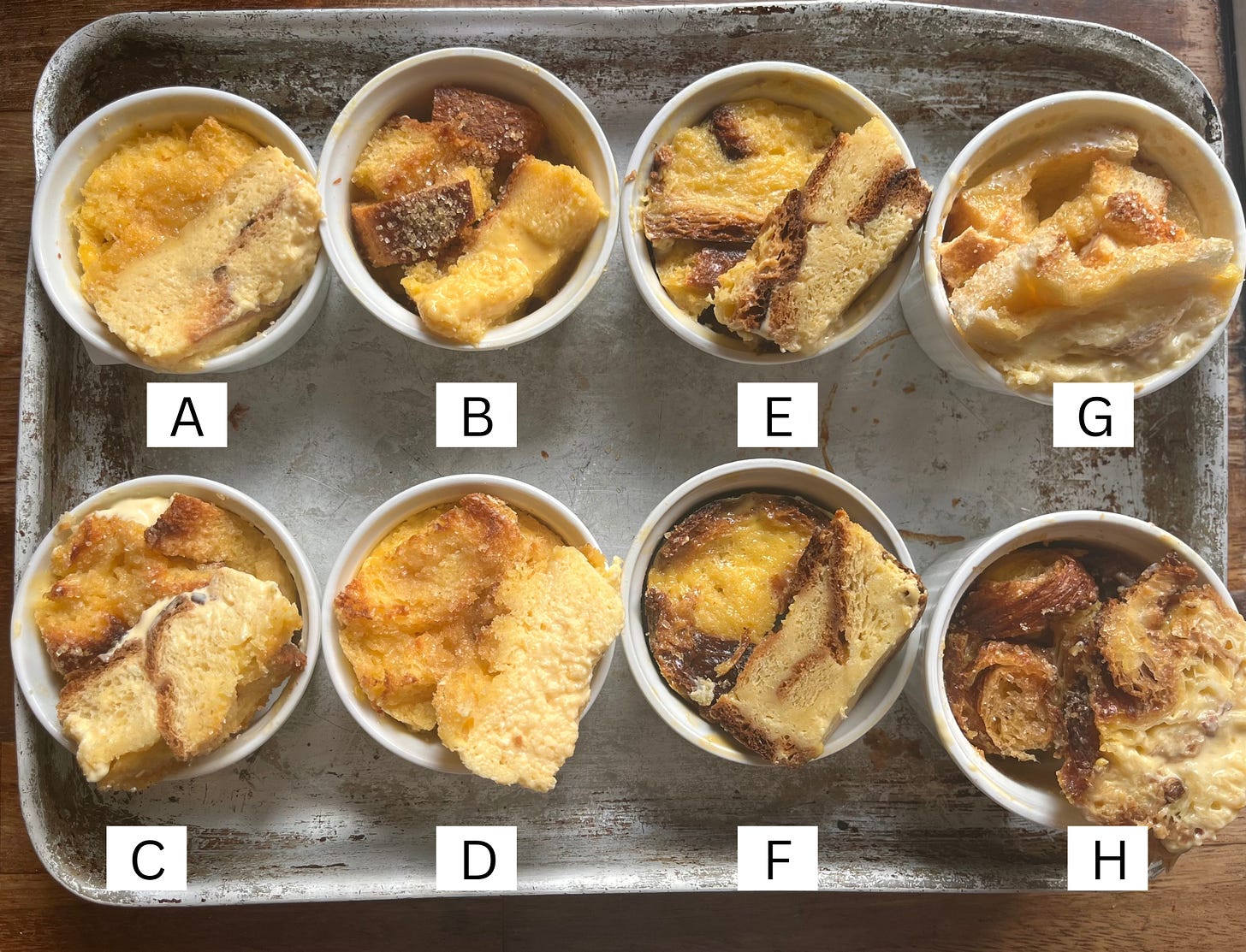

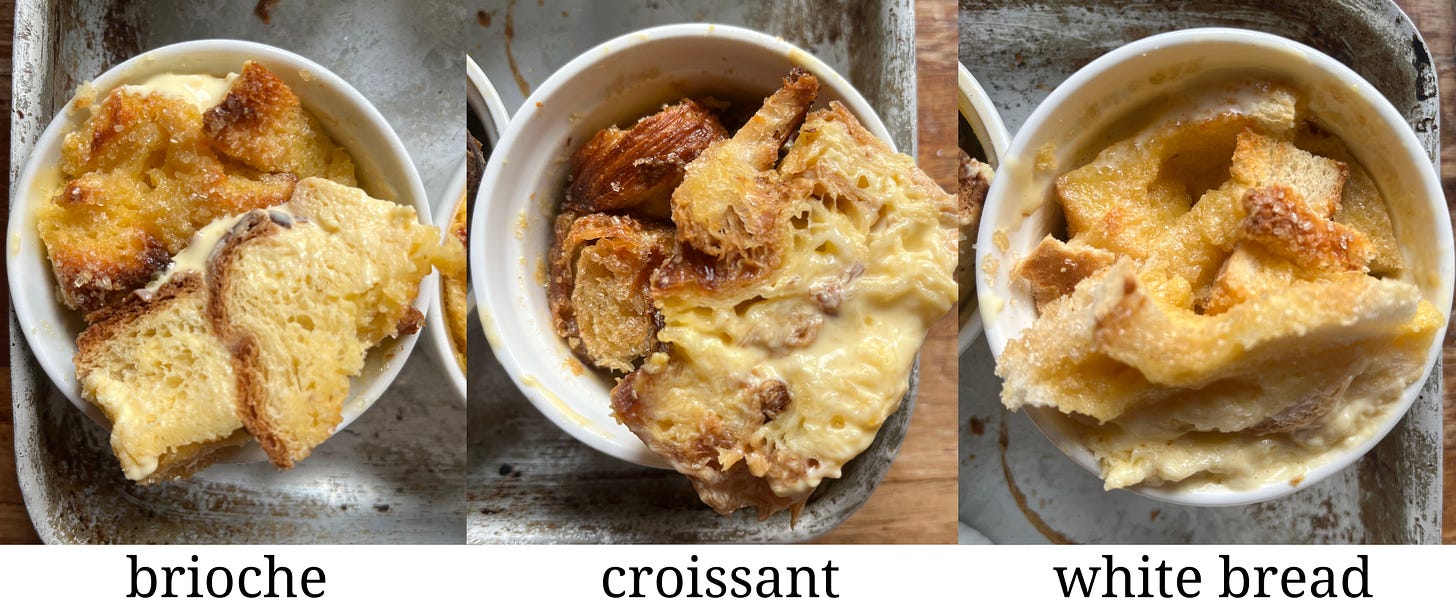
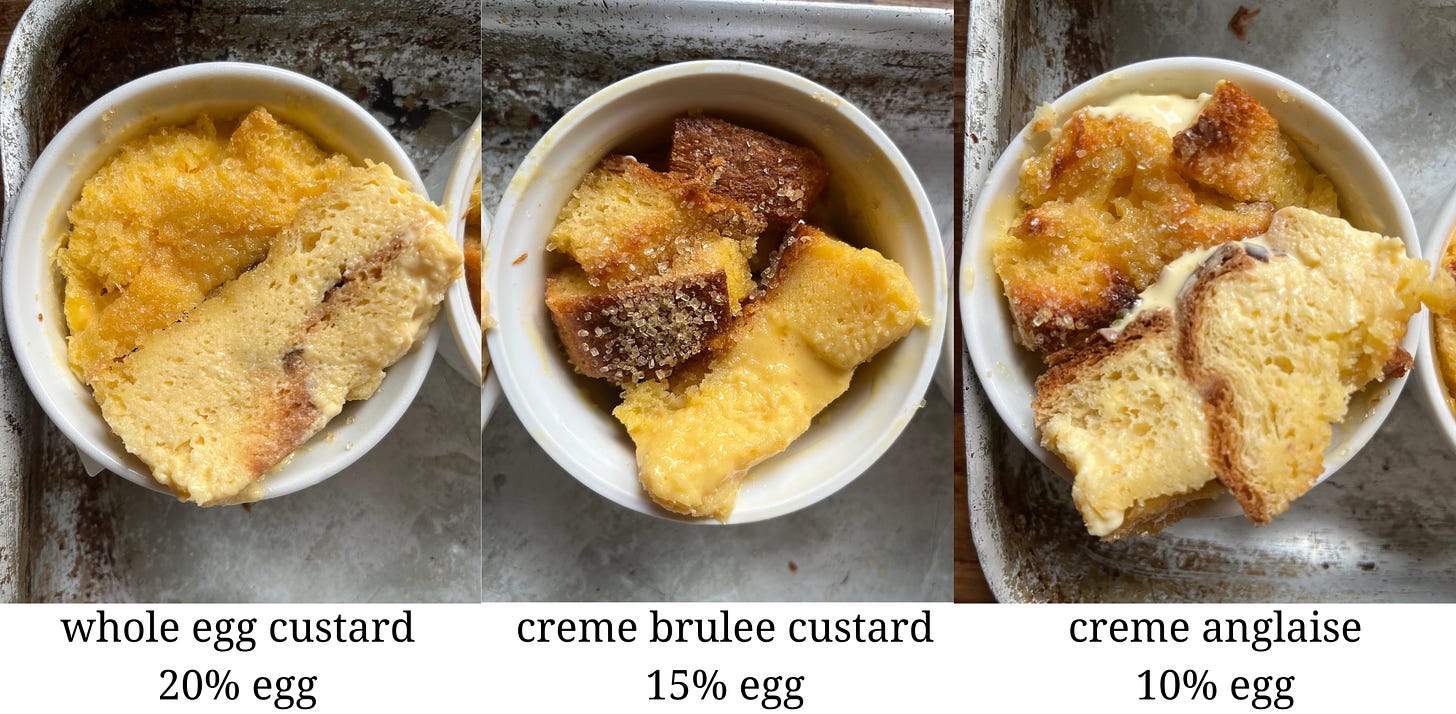

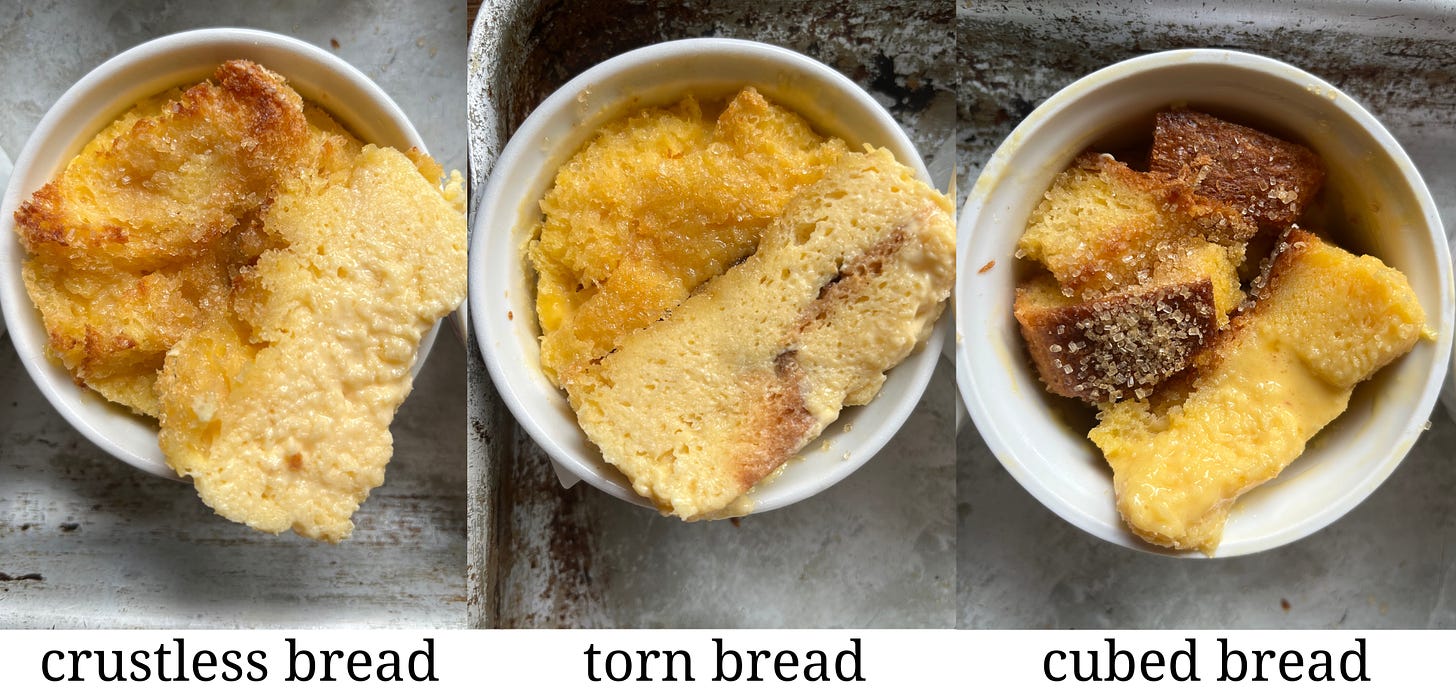

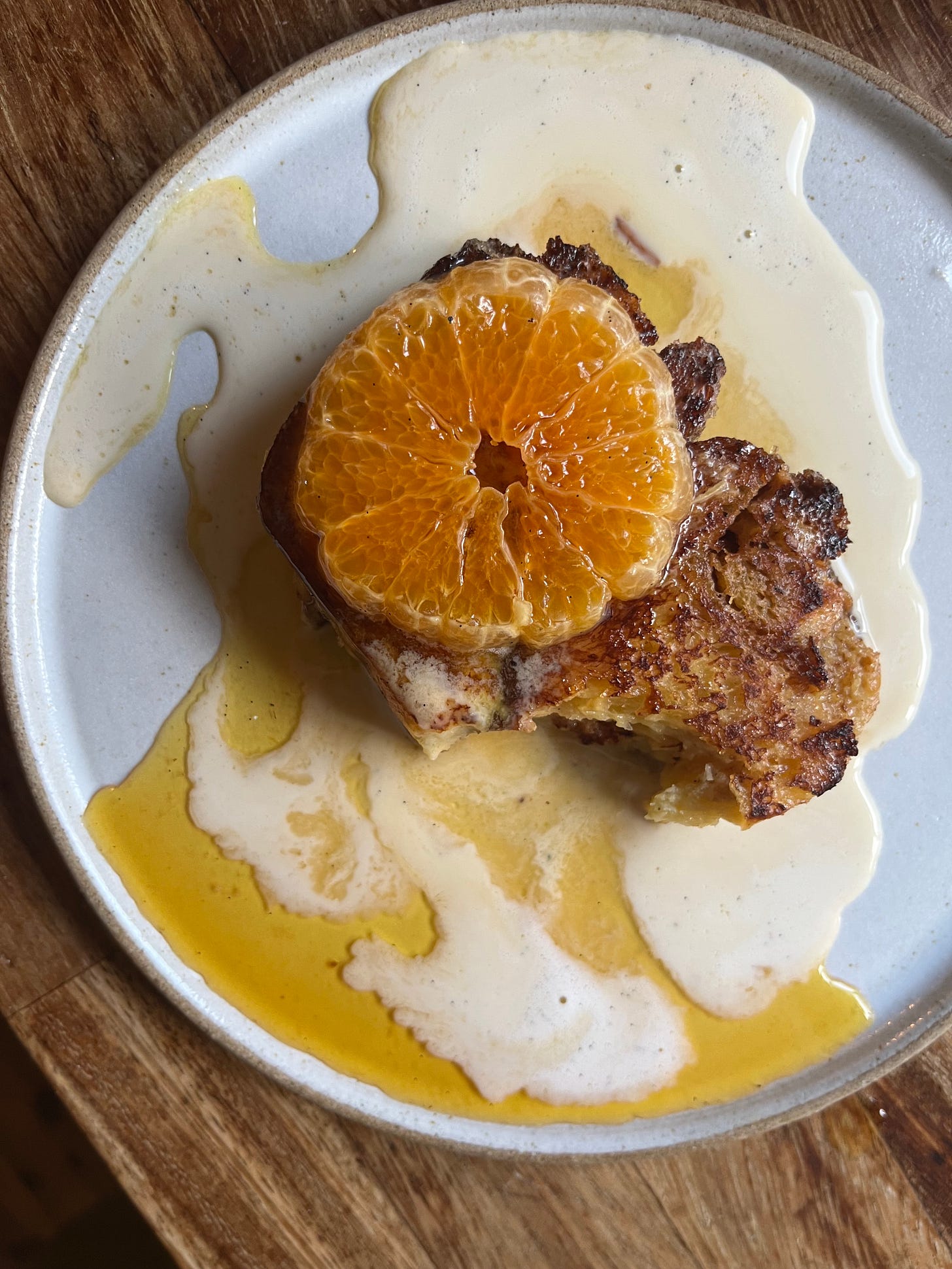

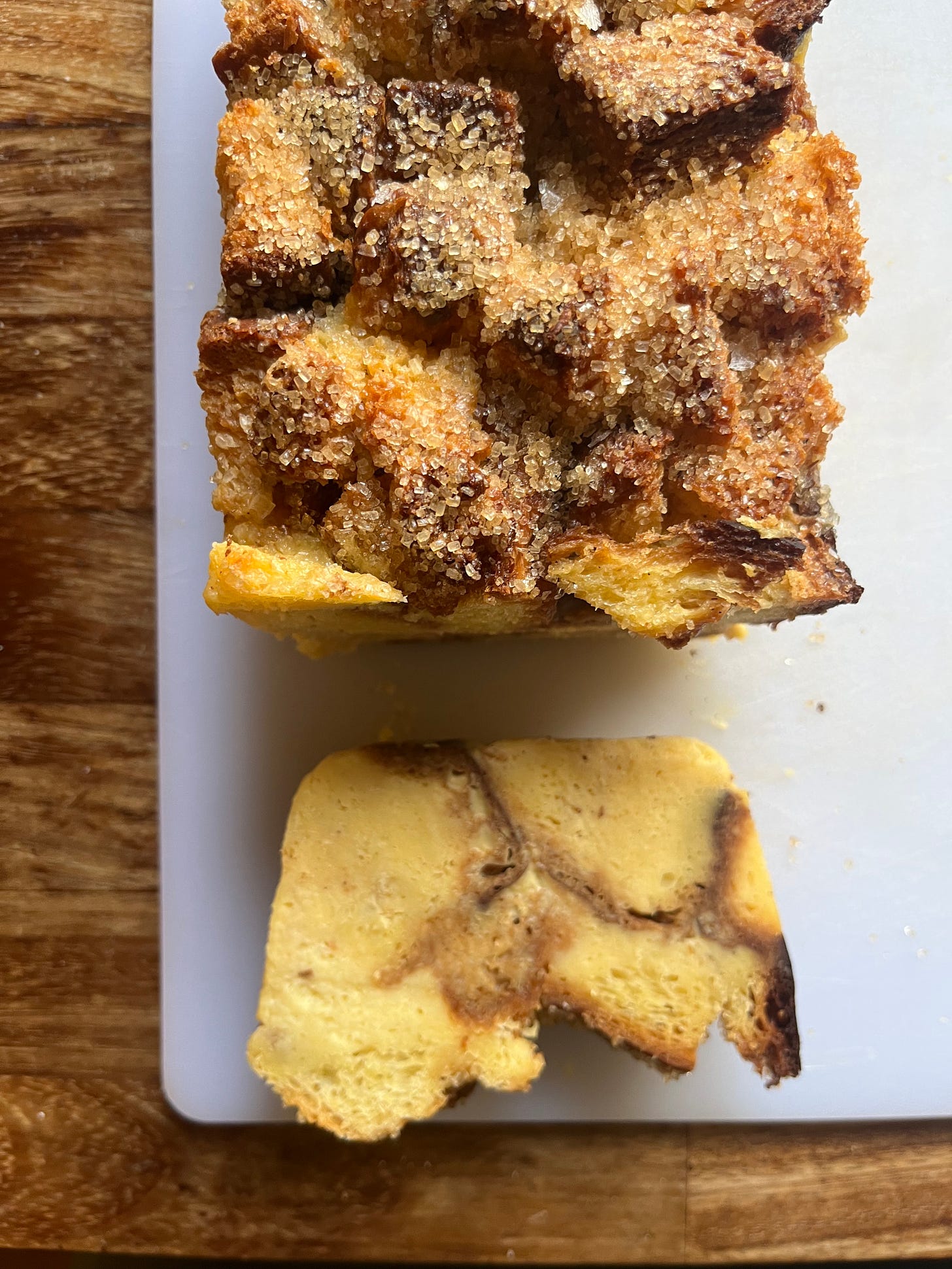

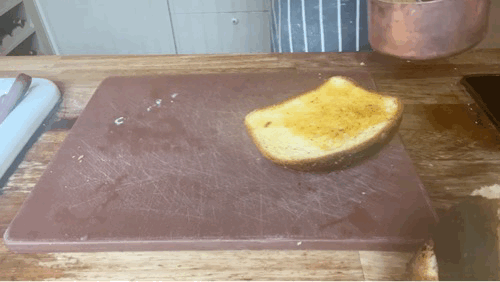
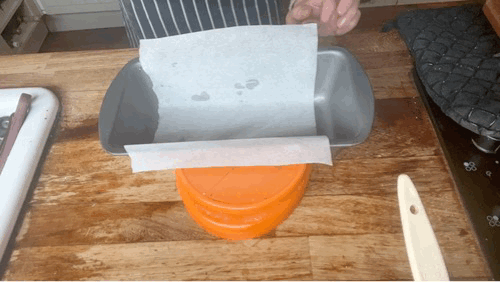

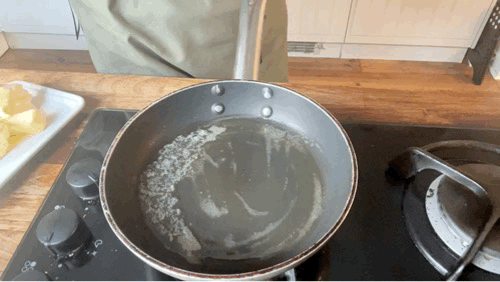
You know how 20 years ago the Sunday paper would be your breakfast staple read. Well this is now it for me. I get beyond excited to receive this! This one is a cracker, can’t wait to make it. The recent Apple pie was stunning! Have a lovely day 🙂
Bread pudding is one of my all time favourite things. Good on the day, even better out of the fridge the following day. Looking forward to this one 😊